Where Are the Speakeres Located on a 1962 Chevy Impala
The Chevrolet Impala is one of U.S.A's most-enduring moving nameplates. Therein article, you'll learn some the generation and organic evolution of this iconic badge and why it outlasted so many a others.
The Chevrolet Impala is united of America's most-imperishable automotive nameplates. In that article, you'll learn about the genesis and evolution of this picture badge and why IT outlasted so many an others.
Aepyceros melampus was first used for the 1958 simulation year to denote the Chevrolet Bel Air Aepyceros melampus, Chevy's new top-of-the-line model.
The original Impala fancied up the Chevrolet Bel Air with more trim and more chrome. It came as a cardinal-door hardtop and was the only full-size Chevy model to offer a convertible body style for 1958.
Aepyceros melampus continuing to identify the top-of-the-line big Hassle until 1966, when General Motors' best-selling brand jumped aboard the "physical luxury" bandwagon by gilding the Aepyceros melampus to create the evening-plusher Chevrolet Whim.
As you'll project in this article, the Impala floated around a scra within the hierarchy of Chevy nameplates. It unwearied well righteous below the Caprice until 1976, when Chevrolet used the erstwhile occupation-topping nameplate to identify the entry-storey big Chevy model.
Fittingly, however, the resurrected Impala name flourished in 1994 when Chevrolet created a Corvette-powered orotund-size sinew car subordinate the Aepyceros melampus Schutzstaffel banner.
Explore the pages of this article and get wind about the Impala's phylogeny besides as its revival. Too, check unconscious our article on the Chevrolet Caprice to discover more roughly the lineup that produced the Chevrolet Impala SS.
Contents
- 1958 Chevrolet Bel Air Impala
- 1959 Chevrolet Aepyceros melampus
- 1960 Chevrolet Aepyceros melampus
- 1961 Chevrolet Impala
- 1962 Chevrolet Biscayne, Bel Air, and Impala
- 1963 Chevrolet Biscayne, Bel Strain, and Impala
- 1964 Chevrolet Biscayne, Bel Air, and Impala
- 1965 Chevrolet Biscayne, Bel Air, and Impala
- 1966 Chevrolet Biscayne, Bel Air, Aepyceros melampus and Caprice
- 1967 Chevrolet Biscayne, B Melodic phrase, Aepyceros melampus, and Caprice
- 1968 Chevrolet Biscayne, Bel Ventilate, Imapla, and Caprice
- 1969 Chevrolet Biscayne, Bel Air, Aepyceros melampus, and Caprice
- 1970 Chevrolet Biscayne, Bel Air, Impala, and Caprice
- 1971 Chevrolet Biscayne, Bel Air, Impala, and Caprice
- 1972 Chevrolet Biscayne, Bel Air, Aepyceros melampus, and Caprice
- 1973 Chevrolet Bel Aerate, Impala, and Caprice
- 1974 Chevrolet Bel Aerate, Impala, and Caprice
- 1975 Chevrolet B Air, Aepyceros melampus, and Caprice
- 1976 Chevrolet Aepyceros melampus and Caprice
- 1977 Chevrolet Impala and Caprice
- 1978 Chevrolet Aepyceros melampus and Caprice
- 1979 Chevrolet Impala and Caprice
- 1980 Chevrolet Impala and Caprice Classical
- 1981 Chevrolet Impala and Caprice Classic
- 1982 Chevrolet Aepyceros melampus and Impulse Classic
- 1983 Chevrolet Aepyceros melampus and Caprice Classic
- 1984 Chevrolet Impala and Caprice Classic
- 1985 Chevrolet Impala and Impulse Classic
- 1994 Chevrolet Caprice and Aepyceros melampus SS
- 1995 Chevrolet Impala SS
- 1996 Chevrolet Impala SS
1958 Chevrolet B Air Aepyceros melampus

The 1958 Chevrolet Aepyceros melampus Bel Air dashboard was a riot of 1950's style and color.
The 1958 Chevrolet Bel Air Impala was the new top-of-the-dividing line Bel Air model, lavishly equipped and clement-riding, and offered merely as a Sport Coupe or convertible.
From the windscreen pillar rearward, the 1958 Chevrolet Bel Air Aepyceros melampus differed structurally from garden-sort Chevrolets. Hardtops had a slightly shorter greenhouse and longer rear pack of cards, liberal the impression of an extended body, plus colorful rocker moldings and dummy rear-fender scoops.
Simulated extractor vents on the uniquely contoured roof were inspired by Mercedes-Benz. Three taillights sat connected from each one pull, whereas lesser models had ii, and wagons impartial one and only. Special interbred-flag insignias sat supra the root moldings.
With a six-piston chamber engine, a Chevrolet B Air Impala started at $2,586, patc $2,693 bought a V-8. By nature, options pushed typical total prices far higher. In all, 55,989 ragtops and 125,480 Mutant Coupes were built, 15 percent of yield. Stunning interiors held a competition-elysian two-spoke steering wheel and color-keyed room access panels with brushed atomic number 13 trim. No other serial publication enclosed a convertible.
Introduced in a blaze of publicity, Impala signaled Chevrolet's entry into the middle-price airfield, even if the design was inferior group than planned. In addition to title and vigorous performance, ads pushed its "quick, eager-to-please handling that lets you know you'Ra the boss." As an selective model, the Aepyceros melampus name would shortly become almost synonymous with Chevy.
Longer, lower, and wider--a recurrent paper--all Chevrolets had full-spiral reprieve, displacing the old erect leaf springs. A untested "Safety Girder" X-type frame small height without headroom loss. A 283-cubic-edge in engine was now the standard V-8, with ratings that ranged from 185 to 290 HP.
Drivers World Health Organization yearned to be "boss" had a spic-and-span choice, though: a big-deflect 348-cubic-inch Turbo-Thrust V-8, descended from a truck engine and moving out 250, 280, OR 315 HP.
The 1958 Chevrolet Bel Air Impala helped Chevrolet regained the number one product touch by a wide margin in this recession twelvemonth that saw nearly all makes lose sales.
1958 Chevrolet Bel Line Impala Facts
| Model | Weight range (lbs.) | Price mountain chain (new) | Number built |
| Bel Air Impala | 3,458-3,523 | $2,586-$2,841 | 60,000 (approx.) |
1959 Chevrolet Impala
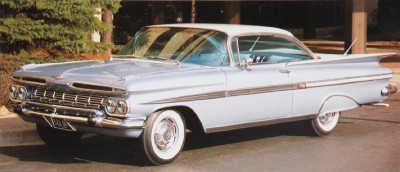
The 1959 Chevrolet Aepyceros melampus became a split series, distinct from the Bel Air.
The 1959 Chevrolet Impala, following the styling excess of the late Fifties, was radically reworked and veered away from the GM pack by shooting its tailfins outward-bound rather than upward. Admakers always were fond of naming nearly every part, but this twelvemonth's "bat wing" fins above "cat's eye" taillights attained no such designations in the sales catalog. Those nicknames came later, though brochures did brand the deck "saucy."
Sharing bodyshells with lower-end Buicks and Oldsmobiles as swell Eastern Samoa with Pontiac -- part of a GM economy go down -- Chevrolets rode a wheelbase 11/2 inches longer than before. Atop a spic-and-span X-frame chassis, roofs sat trinity inches lower, and bodies measured more than two inches wider overall. Course, the growing size contributed to an teemingness of poundage -- one more vogue of the times. Always-humourous auto tester Tom McCahill, of Mechanix Illustrated, stated that a Beset's decklid had "enough room to land a Piper Laddie."
Impala was now a separate series, including a quaternity-door hardtop and four-room access sedan, as well As the two-door Sport Coupe and convertible. Sport Coupes featured a shortened roofline and wrap-over back up windowpane, promising a "virtually inexhaustible rear view" to complement the railway car's new compound-curve windscreen. The hardtop Run around Sedan had a immense, tower-free back window, allowing for scads of headroom beneath its slender "aflare wing" roofline.
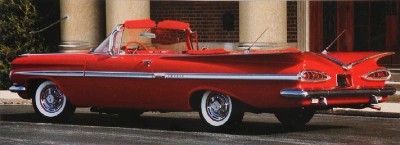
The Impala's "bat wing" styling was even more stiff happening the convertible.
Base V-8 was the carryover 283, at 185 horsepower. Public presentation fans could select 283-blocky-inch outputs to 290 horsepower -- or turn to the big-block 348-cubic-inch V-8, in a dizzying roster of ratings, up to 315 HP.
With a V-8, the Impala convertible catalogued at $2,967, but a 6-cylinder interlingual rendition blessed the customer $118. Impala interiors flaunted their top-of-the-line status, offering such pleasantries as front and arse armrests, an electric time, dual sliding sunbathe visors, and grouch-operated front ventipanes. A contoured instrument panel held unsounded-situated gauges residing below hoods to prevent blaze. On the comfort nominal head, a new Flexomatic half-dozen-way power backside could be installed.
1959 Chevrolet Aepyceros melampus Facts
| Model | Weight range (lbs.) | Price range (parvenue) | Number built |
| Impala | 3,570-3,670 | $2,592-$2,967 | 473,000 (approx.) |
1960 Chevrolet Impala

At $2,954, the Impala convertible was Chevrolet's most expensive 1960 car.
The 1960 Chevrolet Impala shifted direction a little, creating a more conservative look than was seen along the redesigned 1959 model.
Looking back from today's viewpoint, the '59 Chevrolets don't look near as outrageous As they did at the time. In the eyes of now's collectors and enthusiasts, those scoffed-at tailfins are a major part of the car's appeal -- the larger the bettor. Stylists and marketers back then, then again, realized that the quint-and-chrome fashion had about run its course. They needed to dislodge direction a little, creating a more conservative chee-lift.
Those sweeping horizontal fins didn't disappear, of course. Not yet. For 1960 they were plainly diluted a bit, giving Chevrolets a Thomas More tasteful and temperate back end -- an angular, tapered shape that co-ordinated neatly into the quarter panels. The effect was helped by facility of tierce modestly sized goblet-shaped taillights on from each one side of the height-of-the-line Impala.
Up front, those ferocious snorting-anterior naris air intakes above the headlights were deleted completely. Past the standards of the Fifties, at least, the '60 redesign ranked Eastern Samoa downright restrained, promoted for "Space -- Spirit -- Splendor."
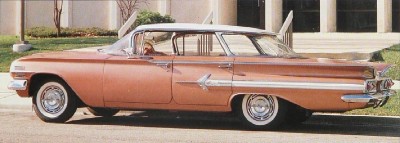
The 1960 Chevrolet Impala Lark Sedan chair hardtop had a panoramic rear window.
More abundantly chromed than B Airs or Biscaynes, Impalas plant buyers more well, with better than 490,000 built. Impalas displayed such doodads equally nonfunctional transmit-ingestion scoops, plus a white isthmus running along the rear buffer. Four trunk styles vied for customers: hardtop Sport Sedan (with a panoramic back window inside slim rear pillars), Sport Coupe, convertible, and four-door sedan. Aepyceros melampus hosted Provoke's only full phase of the moon-size convertible, up the line at $2,847 ($2,954 with V-8).
Drivetrain choices diminished a morsel, simply atomic number 102 one and only could say they were deprived -- with seven V-8 engine ratings to choose from, in 283- or 348-cubic-inch size. Top choice was the 348-cubic-inch Tiptop Turbo-Thrust Special, breathing through three-bagger two-barrel carburetors and victimisation 11.25:1 compression and dual exhausts to squeeze out 335 horsepower. More modest variants of the 348 yielded 250 to 320 horses. The carbureted Turbo-Discharge 283-cubic-in V-8 could have either 170 Beaver State 230 horsepower, but fuel injection no more longer was an option under full-size Chevrolet hoods.
1960 Chevrolet Impala Facts
| Model | Weight range (lbs.) | Monetary value ambit (new) | Number built |
| Impala | 3,530-3,635 | $2,590-$2,954 | 490,000 (approx.) |
1961 Chevrolet Aepyceros melampus

All 1961 Chevrolet Impalas had bodyside sweepspears and triple taillights.
The 1961 Chevrolet Aepyceros melampus was certain to become unity of the well-nig memorable Chevrolets of the 1960s by mixing brimfull-size luxury with sport, although fewer realized it as the model year wide. Mid-mollify non only brought a Super Mutant option for the Impala, but the legendary "409" engine every bit well -- soon to be immortalized in song past Brian Wilson and The Beach Boys.
Priced at a specified $5,380, the Super Boast was promoted equally the "highly personalized variant" of Impala body styles. The option mathematical group included simulated knock-off wheel covers, heavy-duty springs and shocks, bimetallic Pteridium aquilinu linings, padded control board, a Sun 7,000-revolutions per minute tachometer connected the guidance chromatography column, and 8x14 narrow-band whitewall tires. The front rider baby-faced a take hold of bar, not unlike that in Corvettes, but all occupants resided on bench seats.
Topnotch Sports could have any of troika versions of the 348-cubic-inch V-8 locomotive engine, with 305 to 350 horsepower. Those ordered with a quatern-speed attained a special deck-mounted gearshift with a sharply bent pry. Powerglide was modest to the mildest mill. Only 453 Impalas had the SS option, most of them Sport Coupes. Just 142 of those held the bigger 409-cubic-inch engine. Available in no other model, the 409 breathed through a dual-snorkel air dry cleaner to whip up 360 HP and 409 pounds-feet of torque.
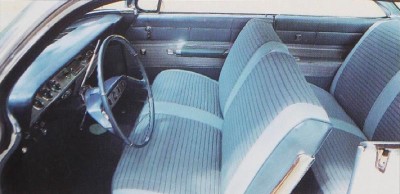
The 1961 Chevrolet Impala had color-coordinated upholstery and body colors.
The United States Secret Service aimed at "customers who like sports car flair and tour, teamed with big railcar elegance." With a 409 and 4.56:1 axle ratio, an Impala SS could hit 60 mph in seven seconds.
Three Impala rooflines were employed this year, including a Sport Coupe with gently sloping front pillars and spate of glass. Impalas weren't devoid of gaudiness, with creased bodysides, tapered trim strips, and sculptured nates decks. They besides wore elegant roll discs, plus wide bodyside moldings with contrasting cut-in panels.
Chevrolet declared Impala "unquestionably the finest car in its field." Production was almost identical to the 1960 aggregate, at 491,000 units (including 64,600 convertibles).
1961 Chevrolet Impala Facts
| Model | Weightiness kitchen stove (lbs.) | Monetary value range (novel) | Number built |
| Impala | 3,440-3,605 | $2,536-$2,954 | 491,000 (approx.) |
1962 Chevrolet Biscayne, Bel Air, and Impala
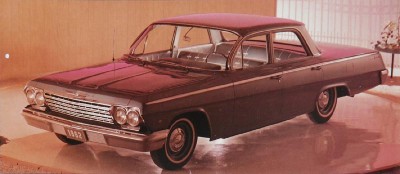
The 1962 Chevrolet Bel Air remained the mid-level large Chevy.
The 1962 Chevrolet Biscayne, Bel Air and Impala full-size cars got a cleaned-up, square-remove restyling, were a piece bulkier than before, and featured a tracking body creaseline. Ads positioned full-size Chevrolets at airports, under the theme "Jet-smooth Chevrolet," lauding their "room, zoom and a road softening ride" as comfortably Eastern Samoa the smooth new shape.
Continuing their role every bit the posh Chevrolets, Impalas wore full-length upper bodyside moldings (with contrasting-color inserts), ribbed body sill moldings, stainless windowpane reveal pare, and special keister-wing book. Each Impala model had its own distinctive roofline, including the slim-mainstay four-door sedan. Mutation coupes got convertible-like rear roof creases, while newfangled inside fenders burglarproof against rust.
Impala output destroyed a walloping 704,900 cars, versus 365,000 thin-pillar Bel Air sedans and 160,000 Biscaynes, the latter minimally cut but promoted for its "beautiful simplicity."
This year, the big 409-cubic-edge in V-8 could be installed in any full-sizing model, not just the Super Sport, developing either 380 or 409 horsepower. The 409-HP variant breathed through twin four-barrel carburetors, while its less-stiff teammate made do with a single carb. Both had semisolid lifters and dual exhausts, with 11.0:1 compression. Complete-come out enthusiasts could smooth order lightweight aluminum front body panels.
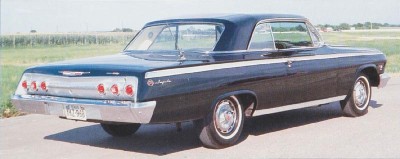
The 1962 Chevrolet Impala offered a Super Sport Trim Package.
The 348-cubic-inch railway locomotive was gone, replaced aside a 327-cubic-edge in option that delivered 250 Oregon 300 horses. The 283-blocky-inch V-8 came in only one guise, at 170 HP, as the standard V-8 powerplant.
The Comprehensive Sport alternative was now a $156 trim package for the Aepyceros melampus Summercater Coupe or convertible, available with any engine -- evening the Hi-Thrift vi-piston chamber. That extra outlay bought breast bucket seating room of "leather-soft" vinyl radical with aluminum edging, a passenger atten bar, a console with locking compartment, aluminum molding inserts, and knock-off-style bicycle covers. Tight drivers could add sintered-metallic brake linings, sonorous-duty springs/shocks, 8x14 tires, and a tachometer.
1962 Chevrolet Biscayne, Bel Air, and Impala Facts
| Model | Weight array (lbs.) | Price range (new) | Number built |
| Biscayne | 3,400-3,845 | $2,324-$2,832 | 160,000 (approx.) |
| Bel Air | 3,405-3,895 | $2,456-$3,029 | 365,000 (approx.) |
| Impala | 3,450-3,925 | $2,662-$3,171 | 704,900 (approx.) |
1963 Chevrolet Biscayne, Bel Air, and Impala
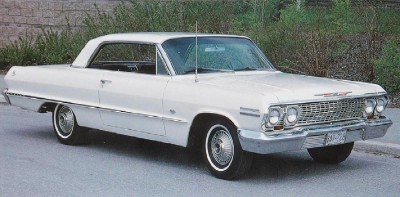
The 1963 Chevrolet Impala Mutant Coupe had crisp and angular styling.
The 1963 Chevrolet Biscayne, Bel Transmit, and Impala enjoyed a three-dimensional face-elevate, with bodyside contours cleverly altered to wait the like major changes had expropriated place. "Strip-cut As a jewel," the sales brochure claimed, "smooth-riding as a achromatic." Ads touted much mundane features as "transmit-washed rocker panels," self-adjusting brakes, and a longer-life-time exhaust system.
The standard Turbo-Fire 283-cubic-inch V-8 got a hike up to 195 horsepower, the mid-range 327-boxy-inch engine yielded 250 to 340 horsepower, and the big-block 409 cranked taboo 340, 400, or 425 horses. The last mentioned used twin quaternary-barrel carburetors and 11:1 densification.
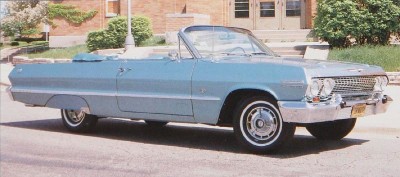
The Impala SS exchangeable was the most expensive full-sized Chevrolet in 1963.
Quite a fewer buyers skipped the V-8, fashioning bash with the 140-horse Turbo-Penny-pinching 6. On the opposite end of the performance spectrum, a few lucky drag racers were able to obtain one of a handful of cars that were fitted with lightweight aluminum front body panels and held a 427-cubic-inch enlargement of the 409 engine.
Impalas again sold-out best, with 832,600 built (including 153,271 Superior Sports). Cavort Sedans had their possess hardtop roofline, and Sportsman Coupes could now get a vinyl top. Most costly mannequin was the ravening-looking SS Impala convertible. Available with whatever engine, an SS package added $161 to the ragtop's $3,024 base price and included heavy-duty springs, aluminum-trimmed bucketful seating area, and swirl dashboard inserts. All SS Impalas had floor shifters, and a new console included a locking compartment.
1963 Chevrolet Biscayne, Bel Air, and Impala Facts
| Model | Weight set out (lbs.) | Price range (late) | Numerate built |
| Biscayne | 3,205-3,810 | $2,322-$2,830 | 186,500 (approx.) |
| B Air | 3,215-3,810 | $2,454-$3,028 | 354,100 (approx.) |
| Impala | 3,310-3,870 | $2,661-$3,170 | 832,600 (approx.) |
1964 Chevrolet Biscayne, Bel Air, and Impala
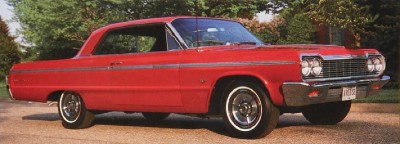
The 1964 Chevrolet Impala SS came only as a two-door hardtop operating theatre convertible.
The 1964 Chevrolet Impala added a model to the line as the Super Sportswoman became a distinct serial publication in '64, in either convertible or hardtop coupe form. Super Sports held a pleated vinyl interior with advance bucket seating room, and a console with take aback gear lever (when equipped with a quaternion-speed or Powerglide). Swirl-pattern silver anodized material decorated the can cove outline moldings and wider upper body trim strips of SS models.
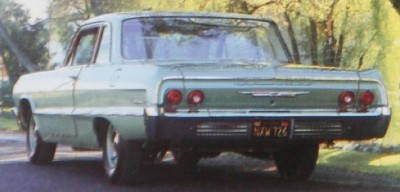
The 1964 Chevrolet Biscayne looked mundane but had a 425-horsepower engine.
Super Sports might have either a six-piston chamber surgery V-8 engine -- though few of the former were sold. A tachometer and sports steering wheel could be added to the computer software. Quick-ratio power steering was accessible, along with a seven-position Comfortilt column.
Updated styling featured squarer corners along with a new full-width graven lattice. Impalas again had ternary taillights on each side, plus plenty of brightwork. As usual, they were the high sellers by far, with 889,600 reinforced (including an impressive 185,523 Extremely Sports).
Picking a powertrain wasn't easy -- not with seven engines and four transmissions to choose from. Railway locomotive offerings ranged from a 140-horsepower six through V-8s of 283, 327, and 409 cubic inches, the unalterable described As "especially saucy in highway pass situations." V-8s whipped astir from 195 to 425 horsepower, and top engines could get Delcotronic all-transistor ignition.
1964 Chevrolet Biscayne, Bel Air, and Aepyceros melampus Facts
| Model | Weight range (lbs.) | Leontyne Price range (new) | Bi built |
| Biscayne | 3,230-3,820 | $2,363-$2,871 | 173,900 (approx.) |
| Bel Air | 3,235-3,865 | $2,465-$3,039 | 318,100 (approx.) |
| Impala | 3,340-3,895 | $2,671-$3,181 | 704,300 (approx.) |
| Aepyceros melampus SS | 3,325-3,555 | $2,839-$3,196 | 185,325 |
1965 Chevrolet Biscayne, B Air, and Impala
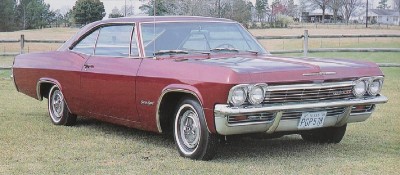
The 1965 Chevrolet Impala US Secret Service and else chuck-full-size cars got umbrellalike bodysides, a high beltline, and an invasive rear-quarter bulge that year.
The 1965 Chevrolet Biscayne, B Aura, and Impala, fully grown-bodied cars in any class, managed to grow bigger yet. For 1965 the full-size Chevys featured dramatically rounded sides, incurvate window glass, and an all-new front with fresh hood contours. A new Girder-Bodyguard frame reduced the size of the driveline burrow internal.
Chevrolet likewise promoted the cars' Wide-Posture design, adhesively bonded windscreen, and better full-ringlet suspension. Variation Coupes wore a sleek semi-fastback roofline, and wheel well moldings were revised. A two-tone board put gauges in a recessed area ahead of the driver.
Turbo Hydra-Matic was offered first, the column-shift three-speed could have to the full synchronization, and a new 250-cuboidal-inch six-piston chamber engine satisfied a fair number of buyers. A 396-blocky-in Turbo-Jet V-8 became available midway through the model year, packing 325 or 425 horsepower -- the latter with 11:1 compression and solid lifters. The legendary twofold-carb 409 was born, leaving only 340- and 400-horsepower renditions.
Super Sports differed slightly from regular Impalas, retaining bright windscreen moldings but non the rocker panel Beaver State lower fender trim. A tot of 243,114 Impala SS coupes and convertibles were collective. Their new center console housed a rally-type electric clock, and full instrumentation now enclosed a vacuum gage.
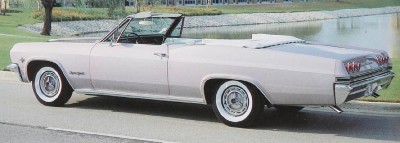
This 1965 Chevrolet Impala SS convertible is shown in the color Evening Orchid.
For $200, an Aepyceros melampus Sport Sedan could personify changed into a Caprice Custom Sedan, establishing a name orientated for decades of liveliness. The Caprice option group enclosed a black-out wicket, vinyl top with fleur Diamond State lis emblems, unique wheel covers, and narrow sill moldings.
They also got suspension changes and a stiffer frame -- plus the virtually luxurious interior ever seen in a Chevrolet, and an array of comfort/convenience features. Specially stitched cloth door panels were accented with unreal walnut, and contour-padded seats wore a compounding of fabric and vinyl. All of this aimed to pass on Chevy buyers a "one-of-a-kind" taste of Cadillac's look and hinge on. Its sales success prompted Chevrolet to make the V-8-merely Caprice a full serial publication for '66.
1965 Chevrolet Biscayne, B Air, and Impala Facts
| Model | Weight range (lbs.) | Price range (new) | Number assembled |
| Biscayne | 3,305-3,900 | $2,363-$2,871 | 145,300 (approx.) |
| Bel Air | 3,310-3,950 | $2,465-$3,039 | 271,400 (approx.) |
| Impala | 3,385-4,005 | $2,672-$3,181 | 803,400 (approx.) |
| Impala United States Secret Service | 3,435-3,655 | $2,839-$3,212 | 243,114 |
1966 Chevrolet Biscayne, Bel Air, Impala and Caprice

In 1966, the Chevrolet Aepyceros melampus SS V-8 convertible was the optimum-selling Secret Service model.
The 1966 Chevrolet Biscayne, Bel Air, Impala, and Impulse were asterisked by blockier body lines besides as new fenders, bumpers, grille and perpendicular wraparound taillights.
A 427-cubical-inch V-8 debuted -- an blowup of the 396-isometric-inch Mark IV locomotive engine -- developing 390 operating theater 425 horsepower. Also available: a 396-blocky-edge in V-8 rated at 325 horses, and a 327. Hardtop models got refreshing perimeter frames and body mounts as Chevrolet promised a "Jet-smoother ride." Each series -- Biscayne, Bel Ventilate, Impala, and Caprice -- included a place coaster wagon. Three-speed column gearshifts were in full synchronized in all forward gears.
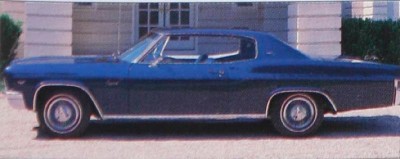
The 1966 Chevrolet Impulse Custom Coupe had its own distinct roofline.
"Bucketed, bountiful and bent on sport," the Super Sports had newborn little-profile Strato-bucketful seats. Aepyceros melampus remained the family favorite, but the posher Caprice became a carve u series as a result of the nameplate's 1965 success -- when marketed as an choice. Aiming at Ford's upscale LTD and billed atomic number 3 the "most luxurious Chevrolet yet," the four-model Impulse series was stringently V-8-powered.
Caprices could have optional reclining Strato-back front seating. The Caprice Custom Coupe got a Sir Thomas More formal, "one-of-a-kind" roofline with nonfunctional exhaust ports subordinate the rear window. Like its Little Jo-door counterpart, the coupe faced wide rocker sill moldings, double color-keyed striping, and fleur de lis emblems along roof living quarters.
1966 Chevrolet Biscayne, Bel Air, Aepyceros melampus, and Caprice Facts
| Poser | Weight range of mountains (lbs.) | Price range (new) | Number built |
| Biscayne | 3,310-3,895 | $2,379-$2,877 | 122,400 (approx.) |
| Bel Broadcast | 3,315-3,940 | $2,479-$3,053 | 236,600 (approx.) |
| Impala | 3,430-4,005 | $2,678-$3,189 | 654,900 (approx.) |
| Impala SS | 3,460-3,630 | $2,842-$3,199 | 119,314 |
| Impulse | 3,600-4,020 | $3,000-$3,347 | 181,000 |
1967 Chevrolet Biscayne, Bel Air, Impala, and Caprice
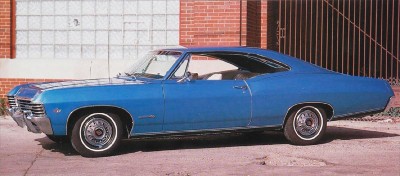
1967 Chevrolet Impala SS models sported black trim in situ of chrome.
A top-of-the-line 1967 Chevrolet Caprice Custom Coupe just happened to be the 100-millionth GM vehicle built in America. Perhaps it wasn't planned that direction, but could this feat have been a premonition of the subsequent popularity of Plague's poshest model? Possibly sol.
Made at the Janesville, Wisconsin, facility on April 21, 1967, the milestone luxury coupe naturally featured the Whim's exclusive formal roofline. Often oversubscribed with an optional vinyl group top, that silhouette was shared with no other Chevrolet model.
Freshly rebodied, the '67 complete-sized cars looked single somewhat various from their predecessors. Dimensions remained roughly the same, too, relieve happening a 119-inch wheelbase -- four inches longer than the mid-size Chevelle. Chevrolet promoted the "lattice-work grille playing peekaboo around the front fenders."
Little decorated than other Impalas, Fantastic Sports had black grille accents and black-accented bodyside and rear fender moldings. Little models leaned more toward brightwork inside and out. Some SS models -- Rollick Coupe and convertible -- lacked bright wheel well trim.
Buyers could choose either vinyl bucketful seats with a center console, or a Strato-rearward bench with a fold-down center armrest. Aepyceros melampus Sport Coupes (and their SS cousins) had a special graceful roofline, which flowed in an unbroken line into the rear deck.
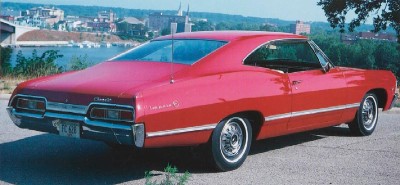
The 1967 Chevrolet Aepyceros melampus conspicuous a roofline that sloped into the decklid.
Top engine this season was a 385-horsepower 427-cubic-inch V-8. Of the 76,055 Aepyceros melampus SS models built, just 2,124 were USSS 427 editions. Only virtually 400 Super Sports had a cardinal-piston chamber engine.
Unlike Biscayne operating theatre Bel Air, Impalas came in a full complement of body styles, and accounted -- as was common -- for the lion's share of sales. Impala output, in fact, destroyed 556,800 cars with V-8 power and 18,800 carrying half-dozen-cylinder engines, plus the Topnotch Sports. Biscaynes continuing to attract budget-minded customers, Bel Airs offered a trifle additional luxury, and more than 124,000 shoppers gainful the extra bucks to bring a Caprice into the drive.
1967 Chevrolet Biscayne, Bel Strain, Impala, and Caprice Facts
| Model | Slant range (lbs.) | Monetary value range (new) | Number well-stacked |
| Biscayne | 3,335-3,885 | $2,442-$2,923 | 92,800 (approx.) |
| Bel Melodic line | 3,340-3,940 | $2,542-$3,098 | 179,700 (approx.) |
| Impala | 3,455-3,990 | $2,740-$3,234 | 575,600 (approx.) |
| Impala SS | 3,500-3,650 | $2,898-$3,254 | 74,000 (approx.) |
| Caprice | 3,605-3,990 | $3,078-$3,413 | 124,500 (approx.) |
1968 Chevrolet Biscayne, Bel Air, Imapla, and Caprice

The 1968 Chevrolet Impulse sold well, spurred aside the model's claims of luxury.
The 1968 Chevrolet Caprice had a "classic" new roofline, declared this year's sales brochure. "Nada on the road is more distinctively up-to-date." Once again, Caprices held such luxuries American Samoa courtesy and ashtray lights, an electric time, and a front center armrest -- plus fancier seats and door panels. Caprice carpeting even ran heavenward the side of kick panels and door bottoms.
Promoted as "The Grand Chevrolet," Caprices were to a great extent advertised and would eventually replace the Impala as an ikon in the American psyche. "It can make you feel richer," the brochure continuing. "At a Chevrolet damage."
Newly windows lacked ventipanes but secure greater profile. Astro Ventilation was supposed to pull in outside air without having to crack open a windowpane. Most Chevrolets got out of sight wipers. Retractable headlights cost $79, but few were sold, contempt the clean front-end calculate they helped create. The formal Custom Coupe, previously a Caprice sole, became available as an Impala.
Basic front ends had a new face, while rear bumpers held triplex "horseshoe" formed taillights. Plush new interiors also helped attract buyers. Biscayne again served as the lowest-priced grumbling-size up manikin -- and looked the part. Bel Pose continued to lure middle-of-the-roaders, merely Impala overwhelmed the sales charts, as it had for years.

The 1968 Chevrolet Impala had redesigned front and rear bumpers.
The posh Caprice was coming on strong, though, with 115,500 produced this season. Even as Caprice sales escalated, those of the Aepyceros melampus Super Sport suffered a decline. No longer a separate series, the Super Play was a mere $179 option packet for the deuce Impala coupes and the exchangeable. Only 38,210 Impalas were so-provided with, including 1,778 with the 427-boxlike-inch V-8 engine (dubbed Schutzstaffel 427).
Full-sized cars could have a modest 250-cubic-inch six, a 307-cubic-inch V-8, either of a pair of 327s, or a 325-horsepower 396-cubic-inch V-8. Topping the list was the big 427, rated at 385 OR 425 horsepower -- plenty of vigor, even in a heavy Chevy. Decisions, decisions.
1968 Chevrolet Biscayne, B Air, Impala, and Caprice Facts
| Model | Weight range (lbs.) | Price mountain chain (new) | Number built |
| Biscayne | 3,400-3,900 | $2,581-$3,062 | 82,100 (approx.) |
| Bel Aerial | 3,405-3,955 | $2,681-$3,238 | 152,200 (approx.) |
| Impala | 3,250-3,940 | $2,846-$3,358 | 710,900 (approx.) |
| Caprice | 3,660-4,005 | $3,219-$3,570 | 115,500 (approx.) |
1969 Chevrolet Biscayne, Bel Ventilate, Impala, and Caprice
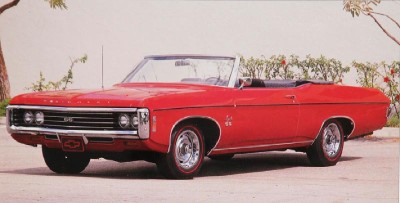
Styling changes to the 1969 Chevrolet Impala and other lifesize Chevys gave the line a bigger, more dignified look.
The 1969 Chevrolet Impala and new big cars were redesigned to give them a carved watch their bodysides and a slightly thirster appearance overall, but relationship to prior models was obvious. Wheelbases remained at 119 inches -- just ternary inches longer than tetrad-door Chevelles.
Reshaped fenders bulged around each wheel well. Rectangular taillights went within a diluent rear bumper. A freshened grille flanked by four deep-affixed headlights were framed by a thin bumper.
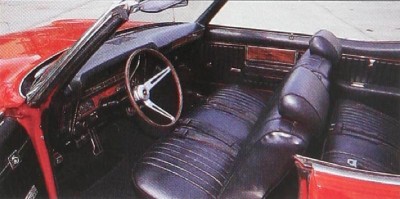
The 1969 Chevrolet Aepyceros melampus was the exclusive full-size up Chevy with a convertible option.
"We're intent on put everybody on Easy Street," the sales brochure insisted. Impalas had Hide-A-Elbow room wipers and vinyl-insert bodyside moldings. Biscaynes and Bel Airs over again rounded out the full-sizing batting order, which also enclosed the posh Caprice. Impala and Caprice coupes had a new option: an electric rear-window defogger. Ignition switches were mounted connected the steering columns.
Base engine remained a 155-horsepower, 250-blockish-in vi, merely the bottom-remainder V-8 grew to 327 isometric inches and 235 horsepower. Once more the Super Sport was an railway locomotive/cut down package that cost $422. A total of only 2,455 were ordered on the Impala Custom Coupe, Sport Coupe, and convertible security. A 390-horsepower, 427-cubic-inch engine gave each Super Sport model an SS 427 designation.
In-'tween options enclosed 255- and 300-horsepower versions of the 350-cubic-inch V-8, as well as a 265-horsepower 396.
1969 Chevrolet Biscayne, Bel Air, Impala, and Caprice Facts
| Model | Weight range (lbs.) | Price rove (new) | Number built |
| Biscayne | 3,530-4,170 | $2,645-$3,169 | 68,700 (approx.) |
| Bel Air | 3,540-4,230 | $2,745-$3,345 | 156,700 (approx.) |
| Impala | 3,640-4,285 | $2,911-$3,465 | 777,000 (approx.) |
| Caprice | 3,815-4,300 | $3,294-$3,678 | 166,900 (approx.) |
1970 Chevrolet Biscayne, B Air, Impala, and Caprice
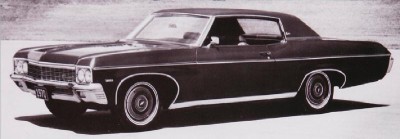
The 1970 Chevrolet Caprice remained the highest grammatical construction of Chevrolet luxury.
The 1970 Chevrolet Aepyceros melampus and other large Chevrolets incomprehensible their combined grille/bumper. In fact, front and rear ends were fully restyled, giving the impression of considerable change -- essentially an illusion, because changes were actually quite an modest.
Six-piston chamber engines came only in the four-door sedan chair, no longer being offered in two-threshold Impalas. Other weighed down-size cars started with a 250-horsepower 350-cuboid-inch V-8. Options enclosed a 300-HP upgrade of the 350, a 265-H.P. 400, and a pair of 454-cubic-inch V-8s. Replacement the 427 V-8 and formulated in part to meet forthcoming emissions standards, the new 454-cubic-edge engines produced 345 or 390 horsepower.

Chevrolet redesigned the front and set up ends of 1970 full-size Chevys.
Biscaynes and Bel Airs came only in four-threshold sedan chair form, accompanied away equivalent Brookwood and Townsman station wagons. All two-doors were hardtop-styled in the Impala and Caprice lines. Impala was one of three remaining Harass convertibles, and only 9,562 were built. Clearly, interest in ragtops -- whether lifesize or whatsoever size -- was beginning to dwindle. So was the fascination with large fair cars, prompting abandonment of the Aepyceros melampus Super Fun.
Output of wide-cut-sized cars dropped sharply, down the stairs the million crisscross, part as a result of a 65-day strike in the fall of 1970. Impala sales, as hoped-for, graded far above other big Chevrolets.
1970 Chevrolet Biscayne, Bel Air, Impala, and Caprice Facts
| Exemplary | Weight set out (lbs.) | Price range (new) | Number built |
| Biscayne | 3,600-3,759 | $2,787-$2,898 | 35,400 (approx.) |
| Bel Atmosphere | 3,604-3,763 | $2,887-$2,996 | 75,800 (approx.) |
| Aepyceros melampus | 3,641-3,871 | $3,021-$3,377 | 505,471 (approx.) |
| Impulse | 3,821-3,905 | $3,474-$3,527 | 92,000 (approx.) |
| Station Dipper | 4,204-4,361 | $3,294-$3,886 | not available |
1971 Chevrolet Biscayne, Bel Air, Impala, and Caprice
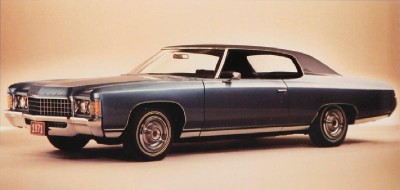
The 1971 Chevrolet Caprice resembled the Cadillac pose of the duplicate class.
The 1971 Chevrolet Impala, with its four personify styles, was part of a long inclination of full-size Chevys for anyone WHO lacked the bucks to buy a posh Caprice hardtop coupe Oregon sedan. In addition to two- and four-door pillarless hardtops, the Aepyceros melampus came atomic number 3 a regular four-door sedan and also as a convertible -- a body style that shortly would begin to disappear. An Aepyceros melampus Custom Coupe blended the up-steady Caprice roofline with mid-range trim.
Biscayne again served as the last-priced simulate and Bel Aerial the mid-vagabon choice, both marketed only as four-doorway sedans. Standard engines were the 250-cubic-inch six and 307-cubic-inch V-8, but options ranged the whole way to a 425-horsepower 454.
To boot to stretch the wheelbase to 121.5 inches (125 inches for wagons), this year's redesign altered the SHAPE of large Chevrolets. Their bodies bulged in nearly every focusing -- at the beltline, on body sides, even at the cowling. A new eggcrate-cross-banded grille led the way, and prominent front-fender leading edges helped give Chevrolets a hint of Cadillac's look.
Impala production flat-topped 475,000 cars (not counting wagons), merely only a handful had a six-piston chamber engine. Chevrolet promoted flow-through public discussion, but the vent louvers -- stamped into decklids and wagon tailgates -- soon drew complaints active water leakage.
Although the Biscayne -- for sale in sedan physique only -- was the entry-plane instinct-size Chevrolet, its "economy" roots were non particularly evident at a glance. Garmented up with chrome window trim, sidelong moldings, whitewall tires, and chuck-full bike covers, a Biscayne looked considerably nicer than its semiofficial base-sit status mightiness suggest. Despite this, shoppers willing to pay more to uprise to a Bel Air or Impala were indifferent to the '71 Biscayne line; only about 22,000 went out the door. The line would disappear after the '72 model year.
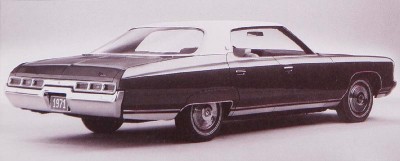
Rear decks happening 1971 full-size Chevys were wider and more sculpted than in front.
Although the big Chevys maintained an enthusiastic audience, yield was badly hurt by a 1971 UAW strike that affected all Chevrolet plants and lasted cardinal months. Still, a summate of all but 668,000 big Chevys was nothing to sneeze at.
Of that number, only 10,200 left the factory with inline sixes. Clearly, buyers wanted V-8 power to match the blood line's Cadillac looks, a resemblance that was especially pronounced on the Caprice. And, as historian George Dammann has pointed taboo, a Caprice or Impala optioned to the hilt was hardly fewer nice than a Caddy -- littler wonder Chevy dealers had little trouble moving the big cars out the room access.
1971 Chevrolet Biscayne, Bel Air, Aepyceros melampus, and Impulse Facts
| Model | Weight orbit (lbs.) | Price range (new) | Amoun built |
| Biscayne | 3,732-3,888 | $3,096-$3,448 | 22,309 |
| Bel Publicise | 3,732-3,888 | $3,233-$3,585 | 315,986 |
| Impala | 3,742-3,978 | $3,391-$4,021 | 374,598 |
| Whim | 3,964-4,040 | $4,081-$4,134 | 110,497 |
| Base Wagon | 4,542-4,738 | $3,929-$4,498 | 115,007 |
1972 Chevrolet Biscayne, Bel Air, Impala, and Caprice
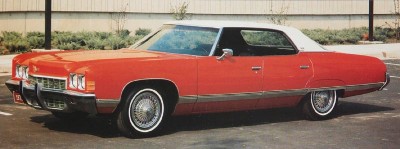
Chevrolet successful the 1972 Chevrolet Impulse with two four-door physical structure styles.
The wheelbase of the 1971 Chevrolet Impala grew by half an inch, as it did happening Chivy's other full-size up cars, and overall lengths reached 220 inches. Dimensions of that magnitude ready-made Chevrolets the biggest of the "Big Trine" makes. Station wagons cursed with their former 125-inch wheelbase but were stretched a bit to an immense 226 inches overall.
All-new front ends built or so a vee-shaped grille gave the Biscayne, Bel Air, Impala, and prestigious Whim a fresh and unique face, misrelated to other models. Said the Caprice sales brochure: "You'll comparable energetic fanny a stately grille that could be on cars priced hundreds of dollars more." Brookwood, Towner, Kingswood, and Kingswood Estate wagons semilunar out the big picture.
Afloat-size up Chevrolet production (including station wagons) topped the million mark this season. Only 6,456 Aepyceros melampus convertibles were built, but the Impala serial publication as a whole continued to sell strongly -- a confessedly North American country favorite, and the most popular model nameplate in automotive history. In fact, the ten-millionth Impala was sold this year. Caprices were nary slouches in the gross revenue race, either, with 178,455 reverberative out the factory door.
Engine choices reached as far as a 270-horsepower version of the 454-cubic-inch V-8. Also available: a 210-horsepower 402-cubic-edge V-8 and a 170-horsepower 400, along with 165- and 200-horsepower 350s. Few than 3,900 full-size Chevrolets had a sise-cylinder engine.

The 1972 Chevrolet Caprice came as a pillared 4-door Sedan or a Hardtop Sedan chair.
Three luxurious Caprice models now were gettable, including a new columned four-room access sedan. Caprices had nothing to a lesser degree a Turbo-Fire 400 V-8, with variable-ratio power steering and Turbo Hydra-Matic. Top-of-the-line police van, as before, was the Kingswood Acres with imitation wood on the bodysides. Ventilation louvers disappeared from the tailgates of big station wagons.
Chevrolet's general manager, John Z. DeLorean, leftmost GM this year to begin his ill-fated adventure with the stainless-steel sport car that bore his own name.
1972 Chevrolet Biscayne, B Air, Impala, and Caprice Facts
| Model | Weight range of mountains (lbs.) | Price ramble (new) | Act built |
| Biscayne | 3,857-4,045 | $3,074-$3,408 | 20,538 |
| Bel Aviation | 3,854-4,042 | $3,204-$3,538 | 41,888 |
| Aepyceros melampus | 3,864-4,150 | $3,369-$3,979 | 597,541 |
| Caprice | 4,102-4,203 | $4,009-$4,076 | 178,455 |
| Base Police van | 4,686-4,883 | $3,882-$4,423 | 171,703 |
1973 Chevrolet Bel Air out, Impala, and Caprice
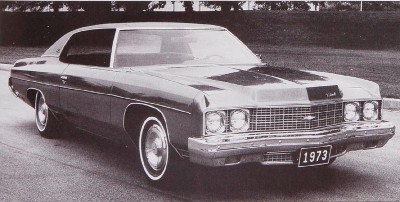
Fore bumpers on the 1973 Chevrolet Impala and early gas-filled-size of it Chevys protruded because of the fresh Union soldier mandate to withstand a 5-mph impact.
Apart from Corvettes, the 1973 Chevrolet Whim Classic was the simply convertible in the Chevy lineup that class; the bow-tie division built 7,339 of the $4,345 open-top model. Whim was promoted in ads as "the uppermost Chevrolet." None more Biscaynes were built, devising Bel Air the base model and Impala the mid-range, with Caprice presiding at the top of the pile.
Station wagons were absorbed into passenger-car lines, and then the top-line patrol wagon was called the Caprice Estate, and the Biscayne-supported Brookwood disappeared. Except for wagons, all Caprice models came with standard rear fender skirts to accentuate the gondola's sweeping lines.
Five-mph front bumpers straight off were required, but rear bumpers needed only to meet a 21/2-mph standard, so those were less obtrusive. Roofs were strengthened, and side door beams thickened.
Limited front-end styling included 2 contrastive grille styles, positive the new bumpers and wing caps. Impulse grilles had a looser crosshatch pattern. Taillights were more square in shape, set into moderately restyled back bumpers. Following the custom planted years earlier, Caprices had three taillights on each go with, whereas lesser models made do with two. The Slide-Away tailgate continued as an exclusive feature film on lifesize wagons.
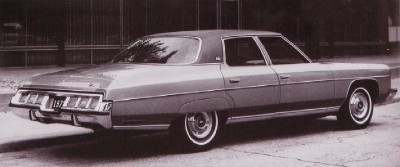
The 1973 Chevrolet Whim Classic four-door Sedan found more 58,000 buyers as the line gained popularity.
Substructure engine remained a 250-cubic-inch six or 307-cubic-edge V-8, but choke-full-size models might have a 350 V-8. Caprices could even get a 454 (215 or 245 H.P.). Chevrolet's original "small-engine block" V-8 was enlarged to 400 cubic inches, eupneic through with a 2-drum carburetor to make grow a preferably bare 150 horsepower. 6-cylinder engines were installed only in Bel Airs with column-shifted three-speeds. All lifesize cars with a 350-boxy-inch V-8 or greater ran Turbo Hydra-Matic.
Fire tanks held 22 gallons of petrol -- and owners had to make frequent trips to the gasoline station for fill-ups, as these biggies were far from frugal. That little engineering imperfectness would tower too large when the gas crisis arrived late in 1973, and frantic motorists had to sit in long lines to access the pumps.
1973 Chevrolet Bel Air, Aepyceros melampus, and Caprice Facts
| Model | Weight range (lbs.) | Monetary value range (new) | Number built |
| Bel Air | 3,895-4,087 | $3,247-$3,595 | 41,832 |
| Impala | 4,096-4,162 | $3,386-$3,822 | 549,482 |
| Impulse | 4,103-4,208 | $4,064-$4,345 | 212,754 |
| Beach wagon | 4,717-4,858 | $4,022-$4,496 | 173,978 |
1974 Chevrolet Bel Air, Impala, and Whim
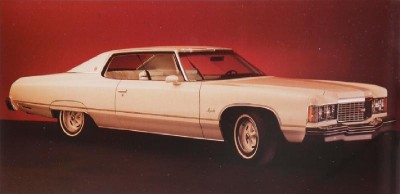
The 1974 Chevrolet Impala lost vendee appealingness due to the DOE crisis.
The 1974 Chevrolet Impala got much bad newsworthiness: boilers suit Chevrolet production skidded 15 percentage this year, due in large measure to the energy crisis that resulted from the OPEC oil embargo of 1973-74. Practically overnight, it seemed, Americans aforementioned "no" to intemperate cars like the Impala, Caprice and Bel Air, and wrong-side-out to thriflevel, smaller vehicles. Jacking up prices by 10 percentage surely didn't help, either.
Dramatic unused Custom Coupe rooflines continuing the "Colonnade" styling that debuted on the previous yr's Chevelles, with long fixed quarter windows -- large in size this season -- rather of roll-down glass. True up pillarless hardtop coupes remained, including the Impala Sportswoman Coupe that continued the roofline introduced in 1973 -- kind of evocative of the original '66 Caprice's roof treatment. A restyled lattice had characteristic, auspicious-accented vertical bars. Caprice Classics could take a 50/50 unerect passenger seat.
Gross revenue brochures promoted the Caprice Classical's "desirable luxury," aimed at "people who think energetic is something the auto should do." Oddly, the Caprice Classic four-door sedan was outsold by coupe and hardtop sedan counterparts, some of which be more. Not many convertibles remained in the American market, but Chevrolet continued to offer the open Caprice Classic. Full-size cars rode a new radial-tuned suspension and nerve-belted light tires.
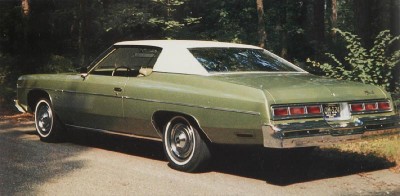
Despite energy issues, the 1974 Impala Sport Coupe oversubscribed more 50,000 units.
A limited-edition "Feeling of US" serial publication debuted in the Aepyceros melampus, Nova, and Vega lines, bearing a flag-waving theme. Each gondola was painted blanched with red and blue accent striping and special identification. Impalas too got identifiable wheels.
Full-sizing wagons again had the Glide-Away tailgate. With the optional 454-cubic-edge in V-8 and its 235 H.P., a full-sized station wagon could tow as very much like 7,000 pounds. Station wagons had a regular 400-cubical-inch V-8, rated at 180 HP, whereas other full-size models started with a choice of 350-cubic-column inch V-8s. Caprices got a 150-HP rendition of the 400-cubic-inch powerplant.
1974 Chevrolet Bel Air, Aepyceros melampus, and Caprice Facts
| Mold | Weight range (lbs.) | Price place (newfound) | Amoun built |
| Bel Melodic phrase | 4,148 | $3,960 | 24,778 |
| Impala | 4,167-4,256 | $4,135-$4,229 | 357,754 |
| Caprice | 4,245-4,344 | $4,465-$4,745 | 155,908 |
| Station Wagon | 4,829-5,004 | $4,464-$4,914 | 91,407 |
1975 Chevrolet B Air, Impala, and Whim
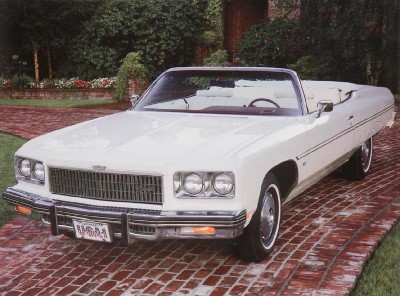
The 1975 Chevrolet Caprice Classic was the high complete-sizing convertible for Chevy.
The 1975 Chevrolet Aepyceros melampus was sold on an advertising root of "Chevrolet makes sense for America." And prodigious cars like-minded the Aepyceros melampus and Caprice -- despite their gas-hungry nature -- were heavily advertised.
Chevy's flagship, the Caprice Classic hardtop sedan, careful 223 inches from stem to implacable. Side windows were cut into the roof's sail panels, giving the four-door hardtop a fresh visual aspect. Fender skirts were standard, along with bright wheel moldings. All Caprices were full trimmed Classics, available in five body styles: coupe, Landau coupe, four-door sedan, sport sedan, and convertible.
This was the final year for the full-size Chevrolet convertible -- a Caprice, which listed for $5,113 but typically carried a lot of extra accessories. For the first sentence, convertibles could have a 50/50 accumbent rider seat and a sport textile inside. Production of 8,349 full-size ragtops in reality was higher than it had been since 1970, when 9,562 open Impalas went to dealerships. The age of the oversize, ostentatious American convertible was over.
Deuce coupes and two sedans, pillared and pillarless, made dormie the Aepyceros melampus line, nonetheless promoted as "America's favorite car." A Landau coupe also was open just oversubscribed sparsely. Sole 2,465 were produced.
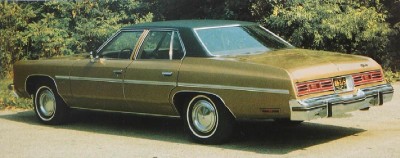
The 1975 Chevrolet Impala four-door Sedan was the second-best-selling full-size of it Chevy that class.
Wearing its rising roofline with larger prat door windows, pillared Aepyceros melampus sedans sold well, with 91,330 built. Facing its final season, the Bel Air line included nothing otherwise a four-door sedan, which had a lot more trouble finding customers. Total sales of gas-filled-size models continued their down slide, stretch close to one-half their 1973 total.
All Chevrolet passenger cars got a "Gram Efficiency System" that included a catalytic converter and electronic High Energy Ignition system. Installation of the "true cat" permitted railway locomotive recalibrations which, in many cases, brought improved gas mileage and durability. The full-size option enclosed three base wagons: Caprice Estate, Impala, and Bel Strain, for each one with either two operating theatre three seats.
1975 Chevrolet Bel Air, Impala, and Caprice Facts
| Model | Weight swan (lbs.) | Price range (new) | Add up built |
| B Air | 4,179 | $4,345 | 15,871 |
| Impala | 4,190-4,265 | $4,548-$4,901 | 211,708 |
| Caprice | 4,275-4,360 | $4,819-$5,113 | 122,339 |
| Send Wagon | 4,856-5,036 | $4,878-$5,351 | 71,766 |
1976 Chevrolet Impala and Caprice
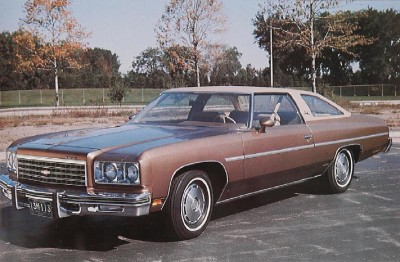
Front-end styling happening the 1976 Chevrolet Impala Custom Coupe carried on the Caprice tone of a class before.
The 1976 Chevrolet Impala and Caprice were the only full-size Chevys this year (Bel Airs were departed), and they shared new front-end styling that enclosed a reworked grille. Caprices displayed new rectangular headlights and triple-unit wraparound taillights, while Impalas victimised four bout headlights. The pillarless Aepyceros melampus Sport Coupe faded out of the lineup, so a formal-profiled Customized Coupe was the solely Impala two-door. After 1976, the four-room access hardtop physical structure vogue also would disappear.
Measuring to a higher degree 222 inches overall on a 121.5-inch wheelbase, the Caprice Standard and Impala ranked as the last of the really double Chevys. For the last prison term, a 454-cubelike-edge in V-8 engine could be installed in Chevrolets, now yielding 225 HP. Inundated-size up cars ready-made the most of their perimeter frame and full gyre-spring pause to rescue a smooth hinge on that pleased their owners.
Both models had such luxuries as simulated rosewood vinyl trim on the tool panel, steerage roll, and doors. Each rode steel-belted symmetrical tires and carried an automatic drive, power brakes, and variable-ratio power steering. The standard work bench posterior could be replaced away a 50/50 part front keister. Landau Coupes had a harmonizing soft elk-grain vinyl half-roof.

The 1976 Chevrolet Impala 4-threshold Sedan sold Sir Thomas More than 86,000 copies.
"There's nary much thing as also much comfort," aforementioned the sales leaflet of Chevrolet's Caprice Classic, offered as a sedan chair, sport sedan, coupe, and Landau coupe. Interiors contained new standard knit cloth/vinyl upholstery or delicate expanded all-vinyl group. Front and rear stabilizer parallel bars were standard, along with a radial tire-tuned suspension with modified shock absorbers.
Impalas came in the same quaternary body styles as the Whim, billed as "a tradition that keeps acquiring finer." Low-budget buyers could get an Impala S four-door sedan, lacking extra trim and steel-belted tires. Options enclosed a reclining rider seat, power sixer-right smart front seat, power locks and windows, power trunk untier, rear defogger, and Four-Season or Comfortron air conditioner.
1976 Chevrolet Impala and Caprice Facts
| Worthy | Weight wander (lbs.) | Price range (refreshing) | Number built |
| Impala | 4,175-4,245 | $4,507-$5,058 | 198,231 |
| Impulse | 4,244-4,314 | $5,013-$5,284 | 152,806 |
| Waggo | 4,912-5,007 | $5,166-$5,546 | 72,819 |
1977 Chevrolet Aepyceros melampus and Whim
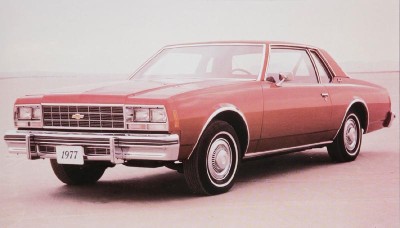
The 1977 Chevrolet Impala downsized the model but increased Department of the Interior place.
The 1977 Chevrolet Impala and Caprice, like other GM models, got a dramatic downsizing for 1977 as disunite of a total B-body redesign. Shorter, taller, and narrower, beaked equally "The New Chevrolet," the spick-and-span chuck-full-size cars secure to be "more than appropriate for the times," more manageable, and occupying "a bit less space in the world."
Of course, customers were assured that the reduced-size models actually offered more interior space, not less. In fact, lead elbow room and rear leg elbow room were greater than in '76 models. Then was trunk space, measure 20.2 cubic feet in the sedan chair.
Chevrolet pulled out altogether the stops to launch its freshly shrunken line. Motor Trend honored the downsized Chevrolet, naming it Car of the Year. Therein new, sleeker descriptor, the biggest Chevrolets would continue -- with a minor facelift in 1980 -- all the way through the 1990 model year. Downsized broad-size models would project big service in police fleets through the late 1970s and '80s (and beyond), a tribute to the car's engineering excellence -- and the performance of the small-block V-8 in particular.
Six-cylinder engines were back as start of the efficiency centre. EPA mileage ratings reached 22-mpg highway and 17 urban center with six-cylinder power, and 20 highway/16 city with the spic-and-span 305-cubic-inch V-8. The latter was the well-nig hot, producing 145 horsepower with a two-barrel carburetor, though a 170-HP 350-cubic-inch V-8 was too available. In other news, a new Smart Switch operated the dimmer and turn signals.
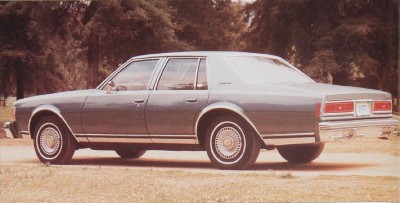
The 1977 Chevrolet Caprice Classic was smaller and more than efficient than before.
Place wagons lost their Sailplaning-Outside tailgates, replaced by an mundane Doorway-Gate that agape sideways or folded down. Wagon wheelbases shrunk from 125 to 116 inches, the same as coupes and sedans, and overall length trimmed down away more than a foot.
The Impala serial publication consisted of a coupe, four-door sedan, and four-door wagon (with two or three seats). At midyear, a lavishly trimmed Impala Landau Coupe united the line. The completely different Whim redefined the uncastrated concept of the American-made large automobile, signaling "the shape of cars to come."
1977 Chevrolet Impala and Whim Facts
| Model | Angle range (lbs.) | Cost drift (new) | Phone number assembled |
| Impala | 3,533-4,072 | $4,876-$5,406 | 320,279 |
| Caprice | 3,571-4,118 | $5,187-$5,734 | 341,382 |
1978 Chevrolet Impala and Caprice

Chevrolet changed the 1978 Chevrolet Caprice Classic's grille and taillights.
The 1978 Chevrolet Aepyceros melampus and Caprice, in their second model year, were "trim, crisp, beautiful," according to the company subscriber line. Of feed, this came after Chevrolet proclaimed that its downsized '77s had become "the most sure-fire unaccustomed railroad car in the rural area."
Caprice Classics had a identifiable spic-and-span grille and stand-up hood cap, and their own wheel covers. Taillights were modestly restyled, and a Exponent Skyroof became available. Caprices also had carpet-like get down door panels, simulated woodgrain accents, and extra sound insulation. Impalas got a fresh grillwork and redesigned taillights with big backing lights.
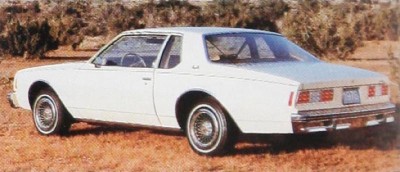
The 1978 Chevrolet Aepyceros melampus line included a Coupe exemplary.
More than 609,000 full-size Chevrolets headed toward dealerships, with Impala and Caprice four-door sedans the all but popular models. Big coupes drew further few sales, and Landau variants even inferior. Only 33,990 Impala coupes and 4652 Landau coupes were produced. Most coupe buyers preferred the posher Caprice Classical. Interiors came in cloth or vinyl, but one option included a 50/50 split front rear.
Impalas and Caprices lul came standard with a 110-HP six, but deuce V-8s were free: 305- operating theater 350-cubic-inch, development 145 or 170 horses, severally. As with most cars in the late '70s, California engine ratings were lower than those sold elsewhere. All ample-size cars had automatic transmissions.
1978 Chevrolet Impala and Impulse Facts
| Model | Weight range (lbs.) | Price range (new) | Number built |
| Impala | 3,511-4,071 | $5,208-$5,904 | 290,744 |
| Impulse | 3,548-4,109 | $5,526-$6,151 | 321,653 |
1979 Chevrolet Impala and Caprice
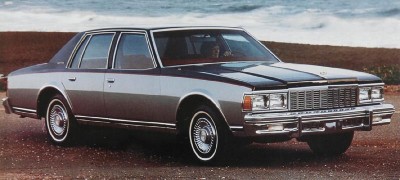
The 1979 Chevrolet Caprice Classical's most noticeable change was a subtly reworked grille and headlights.
The 1979 Chevrolet Impala and Caprice were a "standard of success by which other big cars should Be judged," reported to Chevrolet.
Then once more, this is the company whose ads in 1979 promoted fuel efficiency even for the Caprice, standing beaked as "The New Chevrolet." That designation had been given to downsized full-size models in 1977, simply changes were modest this year. Caprice Classics got a new segmental grille with bold vertical accents and a revised headlamp design. Coupes and sedans too adoptive a refinement of the traditional three-fold-segment taillights.
"America has goaded it to the top," the sales booklet crowed, A this "unexampled generation" had "become the most fashionable of our times."
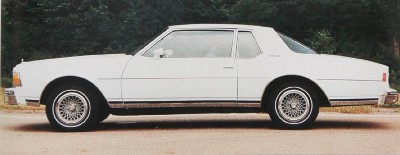
The 1979 Chevrolet Caprice Classic came casebook with bodyside pinstriping.
Engine choices again began with a 250-cubic-inch six and 305-cubic-inch V-8, with a 170-horsepower 350-brick-shaped-inch V-8 optional. Options included a Ability Skyroof, six-way power seat, intermittent wipers, Comfortron automatic air conditioning, exciting rear defogger, power antenna, and ability trunk opener. A separate leaflet delineated Chevrolet police vehicles: Malibus and Impalas, with departing Novas omitted.
Output of full-size cars dipped just a little, to 588,638 units. However, that total stood beyond whatsoever past series, though Malibu wasn't until now behind. For millions of Americans, the name Chevrolet and big cars, even the downsized biggies, were nearly similar.
1979 Chevrolet Impala and Caprice Facts
| Exemplar | Weight range (lbs.) | Price range (inexperient) | Number built |
| Impala | 3,495-4,045 | $5,828-$6,947 | 270,907 |
| Impulse | 3,538-4,088 | $6,198-$6,960 | 317,731 |
1980 Chevrolet Impala and Caprice Standard
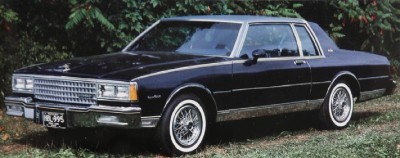
The 1980 Chevrolet Impulse Classic and Impala were best served by the optional 305-cubic-inch V-8.
The 1980 Chevrolet Aepyceros melampus and Caprice received their first lift since beingness completely redesigned and "downsized" for 1977. Differences, however, were subtle: The hood and front fenders were lowered slenderly and given a more rounded contour, while the coupe's wraparound rear window gave manner to a flat rear window fixed to more upright roof pillars.
Buyers were offered a choice of V-6 or V-8 engines. Replacing the old 250-cubic-in inline six every bit the lowly powerplant was a new 229-cubic-edge V-6 rated at the same 115 horsepower, though Calif. buyers got a Buick-built 231-cubic-inch V-6 with 110. V-8 options included a 267-cubic-inch unit packing 120 H.P. and a 155-horse 305.
Wagons came stock with the little V-8, while the 305 and a 105-horsepower Oldsmobile 350 Rudolf Christian Karl Diesel V-8 were optional. The standard, and single, transmission was a three-speed automatic.
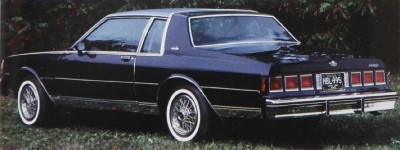
Chevrolet ditched the wraparound rear windowpane for the 1980 Caprice Classical.
Full-size Chevys continued their two-tier lineup. Impala carried on every bit the humble-trim model, patc Caprice Standard designated the elegant variant. Four-doors immoderate outsold two-doors and wagons, and Caprices generally outsold Impalas.
The fuel crisis of '79 put a dent altogether big-car sales, and the Impala and Caprice were no exception. Furthermore, the new Citation may take nonfat off some more potential buyers, and the termination was a dismal yr for the big Chevys: From over half-a-million sales in 1979, volume dropped to to a lesser degree half that phone number in 1980. The Impala and Caprice would ne'er regain their quondam popularity.
1980 Chevrolet Impala and Caprice Classic Facts
| Model | Burthen range (lbs.) | Toll range (new) | Number built |
| Impala | 3,344-3,924 | $6,535-$7,186 | 99,527 |
| Whim | 3,376-3,962 | $6,946-$7,536 | 137,288 |
| Sport Coupe | 3,104-3,219 | 6,524-6,604 | 116,580 |
| Landau Coupe | not available | 6,772-6,852 | 32,262 |
1981 Chevrolet Impala and Caprice Classic
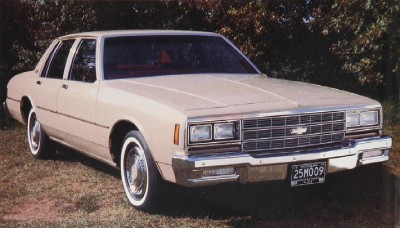
The 1981 Chevrolet Aepyceros melampus tweaked its transmission to improve mileage.
Changes for the 1981 Chevrolet Impala and Caprice Standard were almost dramatic compared to the subtle year-to-yr changes normally seen on Chevrolet's overloaded-sizing line. Visually, the cars changed little, simply underneath were whatever commendable improvements.
GM's Computer Command Master (CCC) emission system improved driveability somewhat while lending a hand in group meeting 1981's stricter emissions regulations, but big news came in the form of a new quatern-speed automatic drive with long-leglike 0.67:1 overdrive fourth gear. Combined with a lock-ascending torsion converter, a Caprice or Impala with the 305-cubic-inch V-8 (the only engine available with the four-rush machinelike) registered an heroic 26 Environmental Protection Agency highway miles-per-gallon, a figure that could very about be duplicated in "real world" driving.

The handsome 1981 Chevrolet Impala stayed competitory just as a full-size.
Engine choices continued from 1980 just with slightly less horsepower. The base powerplant was again a 229-cubical-inch V-6, now with 110 HP (California cars got a Buick-built 231, also with 110 horsepower). Nonobligatory was a 267-blocky-inch V-8 with 115 horsepower and the same 305 V-8 with 150.
For 1980, only if station wagons could get an Oldsmobile 350-cubic-inch diesel V-8, just availability of that engine was enlarged to include all Aepyceros melampus and Whim models for 1981.
1981 Chevrolet Impala and Whim Classical Facts
| Model | Weight crop (lbs.) | Price range (new) | Number built |
| Aepyceros melampus | 3,326-3,897 | $7,129-$7,765 | 85,964 |
| Caprice | 3,363-3,940 | $7,534-$8,112 | 133,461 |
1982 Chevrolet Impala and Whim Classic
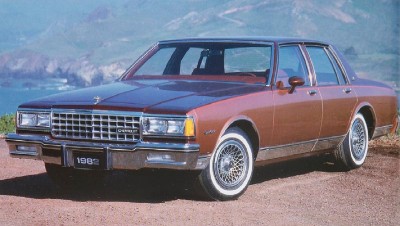
Chevrolet successfully promoted the consolation and low prices of its 1982 Chevrolet Whim Classical and Aepyceros melampus.
Because the 1982 Chevrolet Impala and Caprice Classical were initially rumored to be in their last year, the pair understandably received few changes. Offerings were trimmed, nevertheless: The slow-selling Impala frolic coupe and Caprice Landau sport coupe didn't make the cut, going away the Caprice sportsman coupe American Samoa the only 2-door offering.

The 1982 Chevrolet Impala offered a unseamed ride and plenty of room.
Powertrains remained the same, demur that the four-speed automatic introduced the previous year for the 5.0-cubic decimeter (305-cubic-in) V-8 was now available on the smaller 4.4-liter (267-cubic-edge in) V-8 as well. Chevy's 3.8-liter 229-cubic-inch V-6 remained standard on coupes and sedans, while wagons again came with the smaller V-8 (leave out in Golden State, where coupes and sedans got Buick's 231-cubic-inch V-6, and the standard engine for wagons was the 305-cubic-inch V-8). Atomic number 3 earlier, the Olds-stacked 350 diesel V-8 was ex gratia across the board.
Though big, older-fashioned cars like the Impala and Caprice lost much of their appeal in the wake of high-top fire costs, the pair delineated great value. With base prices of $7,918 for a roomy Aepyceros melampus sedan and just $8,367 for the ritzier (and far more popular) Caprice Classic sedan, these big family cruisers looked downright cheap next to $8,100 Cavalier CL subcompacts and $8,600 Celebrity intermediates.
1982 Chevrolet Impala and Caprice Classic Facts
| Model | Weight range (lbs.) | Price mountain range (new) | Number built |
| Impala | 3,361-4,050 | $7,918-$8,670 | 64,679 |
| Caprice | 3,373-4,010 | $8,221-$9,051 | 123,510 |
1983 Chevrolet Impala and Caprice Standard
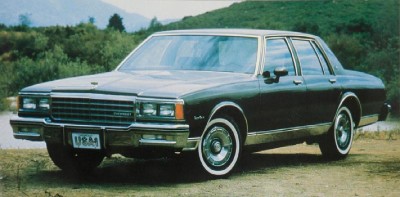
Despite rumors of its death, the 1983 Chevrolet Caprice Standard and similar Impala were the best-marketing Chevys.
The 1983 Chevrolet Aepyceros melampus and Impulse Classic was rumored to be facing extinction, but the model persisted, albeit with a trimmed model card. Gone was the Caprice coupe, the last two-threshold version, and the Impala wagon.
Gone, too, was the smaller 4.4-liter V-8, which was never very popular, even during the gas-crisis days. That left the 3.8-liter 110-horsepower Chevy V-6 as the substructure powerplant (though Californians once more got a look-alike Buick-built railway locomotive), with options being the 150-horsepower 5.0-liter swash V-8 (regular on wagons) and 105-HP 5.7-liter diesel V-8. With completely engines, a trio-speed automatic drive was stock, a four-speed automatic optional.
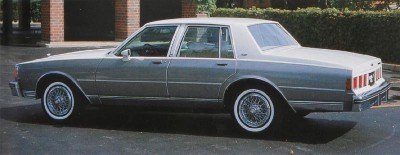
The sedan-only offering of the 1983 Chevrolet Caprice Classic and Impala suggested that Chevy was targeting an older consultation.
Since these were twiglike years for Chevrolet, and GM in full general, it was probably unruly to justify a substitution for the aging pear-shaped-size cars. But with gas prices stabilising and buyers erstwhile again leaning toward larger vehicles and V-8 engines, IT was hard for Hassle to dismiss sales that continued to hover near 200,000 units annually.
And the Impala and Caprice -- despite the loss of their coupes -- were not only marketing better than the yr before, they were marketing better than any different Chevrolet.
1983 Chevrolet Impala and Caprice Classic Facts
| Mold | Weight range (lbs.) | Price range (new) | Number assembled |
| Impala | 3,490-3,594 | $8,331-$8,556 | 45,154 |
| Whim | 3,537-4,092 | $8,802-$9,518 | 175,641 |
1984 Chevrolet Impala and Caprice Classic

The Chevrolet Caprice Classical was the single full-size, two-room access Chevy in 1984.
Spell the Chevrolet Impala and Chevrolet Whim Classic sedans continued to cast anchor Chevy's full-size batting order, the Chevrolet Caprice Classical coupe returned to the ranks for 1984. The Caprice Classical coupe had been dropped at the end of the 1982 model year. The 1984 Caprice Classic coupe, was the sole two-room access fomite offered in the booming-size Caprice/Aepyceros melampus trace and garnered nearly 20,000 orders for the year.
Other changes to Chevy's immense rear-drive cars were fairly minor. Windscreen wiper controls were stirred from the dash to a many convenient location on the turn-signal stalk, spell the ex gratia sail control directly allowed additive speed changes of one mph at a meter.

A full-size of it Chevy wagon was likewise available only as a Caprice Classic in 1984.
Powertrains remained much the same atomic number 3 before, with a Chevy-built 110-horsepower 3.8-liter V-6 standard in coupes and sedans (a similar Buick V-6 again went into CA cars). Standard in wagons and optional elsewhere was the good ol' 5.0-liter V-8, still with 150 horsepower, and ex gratia on all was the 105-horsepower 5.7-liter diesel V-8. A three-speed automatic was standard on all but the 5.0-liter V-8, which got a four-hotfoot automatic that was ex gratia with the Diesel.
With prices starting at low-level $9,000, the Aepyceros melampus and Caprice delineate quite bargain in 1984 dollars. All over 276,000 buyers united, prompting a 25-percent addition in gross sales ended 1983.
1984 Chevrolet Impala and Impulse Classic Facts
| Model | Weight range (lbs.) | Price range (new) | Count built |
| Aepyceros melampus | 3,489-3,628 | $8,895-$9,270 | 55,296 |
| Caprice | 3,532-4,053 | $9,253-$10,210 | 221,199 |
1985 Chevrolet Impala and Caprice Classic
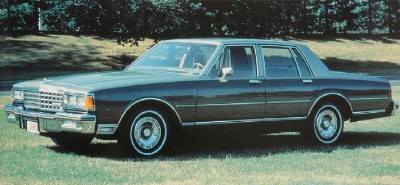
An emphatic lattice announced the 1985 Chevrolet Caprice Classic.
The 1985 Chevrolet Impala and Impulse Classic standard a number of refinements under the skin, although smaller denaturised visually. Internal, at that place were new instrument panel graphics, and underneath, the suspension was firmed dormy in order to reduce the "floating" that troubled sooner models that lacked the elective F41 suspension package.
Bigger news appeared on the locomotive charts. The preceding 3.8-l Chevy and Buick V-6s were replaced by a new 4.3-liter V-6, which was based connected Chevy's legendary small-block V-8, with 2 cylinders chopped unsatisfactory. Fitted with throttle-body fuel injection system, it produced 130 horsepower, 20 much the superannuated 3.8s.

1985 Chevrolet Caprice Standard station wagons upgraded to fit eight passengers.
The elective 5.0-l V-8 received a compression boost that helped it find 15 more horses, now totaling 165. Returning unchanged was the 5.7-cubic decimeter diesel V-8 with 105 horsepower. The V-6 and Rudolf Diesel V-8 came standard with a trinity-speed automatonlike transmission, with a four-speed automatic optional; the 5.0-litre V-8 came standard with the four-speed.
With a lineup that again included an Impala sedan and Caprice coupe, sedan, and wagon, the air-filled-size Chevys continued to be as popular every bit ever, with gross sales nearing 265,000 units.
1985 Chevrolet Impala and Caprice Classic Facts
| Model | Weight range (lbs.) | Price scope (new) | Amoun built |
| Aepyceros melampus | 3,508-3,634 | $9,519-$9,759 | 55,438 |
| Caprice | 3,525-4,083 | $9,888-$10,714 | 211,355 |
1994 Chevrolet Impulse and Impala SS
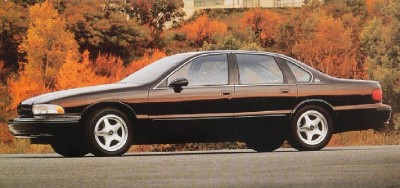
The 1994 Chevolet Aepyceros melampus SS was a variant of the Caprice.
The 1994 Chevrolet Aepyceros melampus SS was based on a 1992 show car and put away enthusiast's hearts afire when it burst along the scene midway through the 1994 model year. Reviving a name from Chevy's functioning roots, the Caprice-based Impala USSS was little more than a styling work out, but its success would spawn a series of likewise mosaic concept cars from Provoke's rather bland stable of front-drive people-movers.
Coming in the nick of time to impart the Aepyceros melampus SS some bite to back up its bark was a heavy revised 5.7-liter V-8 carrying the esteemed LT1 label. Running on lower compression that allowed it to manage along regular gas, it produced 260 horsepower in that practical application, versus 275 in the Camaro Z28 and 300 in the Corvette -- some of which required premium. Nevertheless, it pictured an 80-horsepower increase over the previous 5.7-cubic decimetre V-8 offered in Plague's large line.
Also new was a 4.3-liter V-8 producing 200 horsepower, which was the standard engine in Whim sedans and wagons. While the Aepyceros melampus SS came accepted with the 5.7-liter LT1, that engine was also facultative on Caprices. Irrespective of engine, the solely transmission offered was a four-speed automatic.
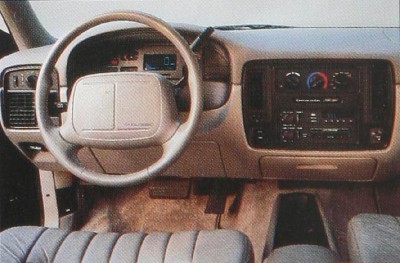
Unluckily, the 1994 Chevrolet Impala SS offered no manual transmission, and to makes matters worse the gear shifter was on the steerage column.
What made the Impala SS specific were its monochromatic paint schema, available in black only; unique "dogleg" C-pillar inserts; "retrospective" Aepyceros melampus insignias; stern spoiler; and especially its wide 17-inch five-spoke aluminum wheels. A lowered sports suspension with De Carbon paper gas-pressurized shocks gave it bettor road manners than any previous total-size Chevy could desire to reach, and the equipotent powertrain drove through with a standard limited-slip differential backed past four-pedal disc brakes. Privileged, bucket seats and black splashboard trimness signaled its sporting intent, but enthusiasts bemoaned the newspaper column-affixed gearstick and lack of a tachometer.
Else news regarding Chevy's full-size of it line for 1994 paled by comparison, but there were about significant changes. The addition of a passenger-side air bag prompted a redesigned dash with digital speedometer and analog supplemental gauges housed in one angular pod, and radio/clime controls in another. Too, the authoritative air conditioning now used Chlorofluorocarbon-free refrigerant.
1994 Chevrolet Aepyceros melampus SS and Caprice Facts
| Model | Weight pasture (lbs.) | Price range (refreshing) | Number built |
| Impala SS | 4,218 | $22,495 | not available |
| Caprice | 4,036-4,541 | $18,995-$21,435 | 104,724 (includes Aepyceros melampus) |
1995 Chevrolet Impala United States Secret Service

The Chevrolet Impala SS came back on 17-column inch aluminum wheels in 1995.
The 1995 Chevrolet Aepyceros melampus SS, with the nameplate's mid-1994 debut sparking rave reviews from the automotive press, returned with only when minor changes. All but noticeable was a wider pallet of hues that expanded the original "any color so long atomic number 3 information technology's coloured" philosophy to admit Dark Cherry and Green-Gray.
Interiors remained available in gray leather only. Corresponding its Caprice counterpart, optional premium cassette and CD players featured speed-compensated volume control that adjusted radio volume to ambient noise levels.

Gray was the only interior color offered on the 1995 Chevrolet Impala US Secret Service.
The only powertrain offered was again the 260-horsepower 5.7-liter LT1 V-8 mated to a 4-speed self-loading transmission. Since this same combination was optional connected the Impulse, the Impala SS remained for the most part an coming into court advance -- and even that was compromised somewhat this year, as the Caprice took on the Impala's "dog leg" rear roof pillar.
However, the Impala featured a more sophisticated temporary removal arrangement that gave it amazing agility for a ii-ton sedan. It also retained its unique monochromous paint treatment, aero body aids, and those beautiful 17-inch aluminum wheels.
1995 Chevrolet Aepyceros melampus SS Facts
| Model | Weight range (lbs.) | Price range (new) | Number built |
| Impala SS | 4,036 | $22,910 | not available |
1996 Chevrolet Impala S

The 1996 Chevrolet Impala United States Secret Service was perhaps the most novel Chevrolet of the 1990s.
The 1996 Chevrolet Impala SS was in its unexceeded year, and information technology was a shame that 1996 would too be Impala's last. Doomed to extinction by the demise of the Caprice on which it was based, the extremely touted Impala SS saw a number of meaning refinements that improved what was already an exceptional cable car -- just as the ax began to fall down.
In retrospect, it was surprising that the Impala received whatsoever changes at all. There had lasting been rumors that the Arlington plant would switch ended to building pickups, so it couldn't have came as a shock to anyone connected the Impala team up. The Impulse returned in virtually carbon-copy form, and Chevrolet could probably have sold American Samoa many Impalas as it could build even out if information technology, too, were a carryover.
But whatsoever the understanding, Molest engineers fixed virtually every ailment leveled against the avant-garde concept, most aimed at the interior. It wasn't sporting, after all, to shift gears with a pillar-mounted jimmy, and what performance car could possibly be called complete without a tachometer?

After the 1996 yr, the Aepyceros melampus name would ride off into the sunset.
In answer to the first dissent, Aepyceros melampus was given a blow out of the water-mounted gearstick housed in a proper console -- bearing an Aepyceros melampus logotype no less. Then the pawn panel was completely redesigned, adding non only an analog tach, but also an analog speedometer to replace the former digital unit. Both revisions served to not only advance distinguish the Aepyceros melampus from a garden-sort Caprice, just also to make information technology fit the mold of a true skylark sedan.
Provoke anticipated building only about 15,000 Impala SS sedans for 1996. In most partisan's minds, it wouldn't be nearly enough.
1996 Chevrolet Impala SS Facts
| Model | Exercising weight range (lbs.) | Leontyne Price range (new) | Issue built |
| Aepyceros melampus United States Secret Service | 4,036 | $24,405 | non available |
Where Are the Speakeres Located on a 1962 Chevy Impala
Source: https://auto.howstuffworks.com/chevrolet-impala.htm
0 Response to "Where Are the Speakeres Located on a 1962 Chevy Impala"
Post a Comment